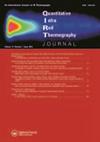用振动热成像技术检测表面裂纹
IF 4.9
3区 工程技术
Q1 INSTRUMENTS & INSTRUMENTATION
引用次数: 5
摘要
本文章由计算机程序翻译,如有差异,请以英文原文为准。
Surface crack detection by using vibrothermography technique
ABSTRACT This paper aims to optimise the vibration frequency that produces the highest temperature difference between crack location and non-defect location. The optimisation was based on thermoelastic damping analysis, and the analytical frequencies were varied between 10 Hz and 100 kHz. The result of optimisation was frequency 20 kHz for this study. In experiments, the effects of vibration frequency and vibration amplitude were studied. The experimental frequencies were 4.7, 20, 24 and 28 kHz. The piezoelectric disc was used as a sensor to measure the vibration amplitude on crack location. Then, the measured amplitudes were read in terms of the output voltage from the piezoelectric disc as 2, 4, 6 and 10 Vrms. The maximum difference in temperature between crack and non-defect locations was 0.33°C, which was obtained from vibration frequency of 20 kHz. Using high vibration amplitude did not significantly increase the temperature difference between crack and non-defect locations.
求助全文
通过发布文献求助,成功后即可免费获取论文全文。
去求助
来源期刊

Quantitative Infrared Thermography Journal
Physics and Astronomy-Instrumentation
CiteScore
6.80
自引率
12.00%
发文量
17
审稿时长
>12 weeks
期刊介绍:
The Quantitative InfraRed Thermography Journal (QIRT) provides a forum for industry and academia to discuss the latest developments of instrumentation, theoretical and experimental practices, data reduction, and image processing related to infrared thermography.
 求助内容:
求助内容: 应助结果提醒方式:
应助结果提醒方式:


